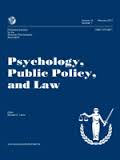 he rapid growth of the PCL-R in courts is largely accounted for by prosecution cases against sexually violent predators or in parole hearings. This is the bottom line of a recently published article in Psychology, Public Policy, and Law. Below is a summary of the research and findings as well as a translation of this research into practice.
he rapid growth of the PCL-R in courts is largely accounted for by prosecution cases against sexually violent predators or in parole hearings. This is the bottom line of a recently published article in Psychology, Public Policy, and Law. Below is a summary of the research and findings as well as a translation of this research into practice.
Featured Article | Psychology, Public Policy, and Law | 2014, Vol. 20, No. 1, 96-107

Investigating the Role of the Psychopathy Checklist–Revised in United States Case Law
Author
David DeMatteo, Drexel University
John F. Edens, Texas A&M University
Meghann Galloway, Drexel University
Jennifer Cox, Texas A&M University
Shannon Toney Smith, Texas A&M University
Julie Present Koller, Drexel University
Benjamin Bersoff, Emory University
Abstract
Although the Psychopathy Checklist-Revised (PCL-R; Hare, 2003) appears to be the most widely used measure of psychopathic traits in forensic settings around the world, relatively little is known about how often it is introduced into legal cases and the types of cases in which it is being used. DeMatteo and Edens (2006) first summarized the extant U.S. case law on the PCL-R, identifying 87 cases in which it had been introduced since its publication in 1991 through 2004. Using an identical search strategy employed in the earlier review (LexisNexis legal database), we identified 348 cases involving the PCL-R from 2005 through 2011. Notably, the PCL-R appeared to be primarily a “prosecution tool” in these cases in that it was rarely first introduced into evidence by the defense. In most cases it was used to assess offenders with significant histories of violence in the context of risk assessments—with resulting risk statements being strongly associated with the results of the PCL-R evaluation (i.e., high psychopathy equating with high recidivism risk, low psychopathy equating with low recidivism risk). Challenges to the admissibility of PCL-R evidence in these cases were rare and typically unsuccessful, even though some assertions, particularly in relation to the PCL-R’s predictive validity, appeared to have questionable scientific support. On average, prosecution examiners reported PCL-R scores that were 7 points higher than defense examiners. We discuss these findings in the context of the appropriate roles for the PCL-R in court and its potential for misuse when evaluating psycho-legal issues.
Keywords
Violence, risk assessment, survey, international, mental health
Summary of the Research
The main objective of the study was to analyze the use of the Psychopathy Checklist-Revised (PCL-R) in 348 U.S. court cases between 2005 and 2011. The three states with the largest number of cases were California, Texas, and Minnesota. The demographics of the cases included 341 males and seven females with a mean age of 47.78; race was not reported for the cases.
An overwhelming majority of cases (61.8%) were directed towards sexually violent predators. Coinciding with this finding, extensive histories of violence were the most sought after detail from a defendant’s background. Another major finding was that nearly 25% of the cases were related to parole determination, a clear increase from 15% in 2006. The state of California has made the PCL-R a regular component in parole hearings, which makes it a powerful predictor of release decision-making in that state.
The PCL-R was used most often to assess risk for future danger (92%), then general recidivism risk, and then behavioral abnormality. The average PCL-R score was 25.29 in these cases whereas the average score for male prisoners in North America is 22.1.
Consistent with previous research, the PCL-R was primarily used by the prosecution in two-thirds of observed cases. Alternative risk assessment instruments were used in conjunction with the PCL-R 85% of the time. Given that the PCL-R was used in sexually violent predator cases most frequently, secondary tools like the Static-99 were also used. Evaluators retained by the prosecution reported PCL-R scores that were 7 points higher than those reported by defense evaluators.
Translating Research into Practice
The PCL-R is increasingly being used in federal and state cases throughout the United States. The occurrence of PCL-R usage has increased from 87 cases between 1991-2004 to 348 cases in this study’s timeframe of 2005-2011, especially in California for parole cases and sexually violent predators, which may indicate a future direction for research.
With the surge in the use of the PCL-R, it is important for clinicians and researchers to continue to develop accurate and accessible scales and subscales. Unfortunately, PCL-R subscales were only used in 3% of the analyzed cases. This stark statistic may indicate the need for further professional training in order to utilize the tool to its fullest capacity. In addition, the PCL-R was considered narrowly by the courts as a risk assessment tool. A challenge for clinicians will be to flush out the potential for the PCL-R to provide the courts with informed decisions regarding offenders. A related challenge is to improve the ways in which PCL-R scores can assist professionals outside the field of psychology.
Results also demonstrated that the relationship between PCL-R scores and future violence risk was being distorted to reflect strong predictive validity despite previous research indicating otherwise. The authors believe this overestimation to be the result of certain clinicians citing one study that favors a stronger relationship rather than referencing the breadth of research on the PCL-R. This misguided thinking can cause clinicians to arrive at “global risk conclusions” that are based more on the interpretation of a score rather than the value of the scores themselves. For example, the authors state that 88% of the time, a high score automatically meant the defendant had high risk of recidivism. “Because the PCL-R is not a risk assessment measure per se, evaluators should be cautious when making risk assessment statements based on PCL-R results,” (p. 103).
Both the prosecution and the defense appear to use the PCL-R to their own advantage. In 20% of all cases, the defense introduced the PCL-R score but only if it was a low score. When an expert was brought in by the defense to comment on the defendant’s PCL-R score, 65% of those experts would rate the defendant as having a low score. Overall, the defense appeared to worry about the threat of labeling. That is, the threat of labeling an individual as a psychopath appeared to discourage the defense from using the PCL-R, especially in capital cases. Even in the absence of high PCL-R scores, the defense appeared to demonstrate concern that even the mention of the word “psychopath” would prejudice their client. On the flip side, PCL-R scores were usually higher when the prosecution brought in an expert; 83% scored offenders as “high.” Experts brought in by either the prosecution or the defense need to maintain a high level of impartiality in order to give consistent scores for the same individual.
Most of the cases reported using another risk assessment tool in tandem with the PCL-R. The authors urge that evaluators be mindful of “double-dipping” when it comes to multiple risk assessment instruments. This refers to the tendency for similar scales and tools to count the same score more than once. For example, the VRAG scale heavily weighs the PCL-R score so also considering the PCL-R separately would be weighing that one data point twice.
Other Interesting Tidbits for Researchers and Clinicians
The PCL-R was relatively unchallenged when entered into evidence. This did not reflect the notion that the PCL-R is accepted wholeheartedly by the legal field but demonstrates the ease with which it is introduced and allowed. “The relatively low number of challenges to the admissibility of the PCL-R—as well as the relative absence of cases where it appears to be applied to questionable psycho-legal topics (e.g., malingering, competence to stand trial)—is also noteworthy in light of recent concerns about the probative value and prejudicial impact of the PCL-R in relation to certain types of cases (e.g., capital murder) and with certain populations (e.g., juveniles),” (p. 105).
Join the Discussion
As always, please join the discussion below if you have thoughts or comments to add!






















